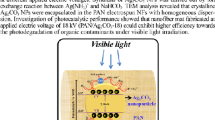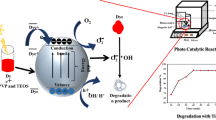Abstract
In this study, polyvinylidene fluoride-co-hexafluoropropylene (PVDF-HFP)–based nanofibers were produced by electrospinning technique on aluminum substrate and coated with magnetron sputtering technique by using Cu2O photocatalyst target material. Resulting materials were characterized by SEM, EDX, and UV diffuse reflectance spectroscopy. Photocatalytic activity of the material was tested against methylene blue decolorization under 105 W tungsten light bulb. Methylene blue concentration was followed up by UV visible spectrophotometer at 664 nm. Kinetic modeling of the photocatalytic reaction was found suitable to the first-order kinetics. Reaction rate constants were 0.0037, 0.0044, and 0.0050 min−1 respectively with corresponding half-life times of 187, 158, and 139 min. Thanks to the genuine design of the catalyst, it allowed easy removal of the material from the solution without any residue by simple tweezers which is a promising step for getting rid of heavy and low yield of filtration processes in the separation of particulate catalysts from the treated water.

.









Similar content being viewed by others
References
Heikkilä P, Taipale A, Lehtimäki M, Harlin A (2008) Electrospinning of polyamides with different chain compositions for filtration application. Polym Eng Sci 48(6):1168–1176
Huang ZM, Zhang Y, Kotaki M, Ramakrishna S (2003) A review on polymer nanofibers by electrospinning and their applications in nanocomposites. Compos Sci Technol 63(15):2223–2253
Frenot A, Chronakis IS (2003) Polymer nanofibers assembled by electrospinning. Curr Opın Colloıd In 8(1):64–75
Hwang K, Kwon B, Byun H (2011) Preparation of PVdF nanofiber membranes by electrospinning and their use as secondary battery separators. J Membr Sci 378(1–2):111–116
Zhou Z, Wu XF (2015) Electrospinning superhydrophobic–superoleophilic fibrous PVDF membranes for high-efficiency water–oil separation. Mater Lett 160:423–427
Wu CM, Chou MH (2016) Polymorphism, piezoelectricity and sound absorption of electrospun PVDF membranes with and without carbon nanotubes. Compos Sci Technol 127:127–133
Lee EJ, An AK, Hadi P, Lee S, Woo YC, Shon HK (2017) Advanced multi-nozzle electrospun functionalized titanium dioxide/polyvinylidene fluoride-co-hexafluoropropylene (TiO2/PVDF-HFP) composite membranes for direct contact membrane distillation. J Membr Sci 524:712–720
Spasova M, Manolova N, Markova N, Rashkov I (2016) Superhydrophobic PVDF and PVDF-HFP nanofibrous mats with antibacterial and anti-biofouling properties. Appl Surf Sci 363:363–371
Solarajan AK, Murugadoss V, Angaiah S (2017) High performance electrospun PVdF-HFP/SiO2 nanocomposite membrane electrolyte for Li-ion capacitors. J Appl Polym Sci 134(32):45177
Xu H, Wang W, Zhu W (2006) Shape evolution and size-controllable synthesis of Cu2O octahedra and their morphology-dependent photocatalytic properties. J Phys Chem B 110(28):13829–13834
Zheng Y, Wang Z, Peng F, Wang A, Cai X, Fu L (2016) Growth of Cu2O nanoparticle on reduced graphene sheets with high photocatalytic activity for degradation of rhodamine B. Fullerenes, Nanotubes and Carbon Nanostructures 24(2):149–153
Miao J, Xie A, Li S, Huang F, Cao J, Shen Y (2016) A novel reducing graphene/polyaniline/cuprous oxide composite hydrogel with unexpected photocatalytic activity for the degradation of Congo red. Appl Surf Sci Sci 360:594–600
Trotochaud L, Ranney JK, Williams KN, Boettcher SW (2012) Solution-cast metal oxide thin film electrocatalysts for oxygen evolution. J Am Chem Soc 134(41):17253–17261
Zheng MJ, Zhang LD, Li GH, Shen WZ (2002) Fabrication and optical properties of large-scale uniform zinc oxide nanowire arrays by one-step electrochemical deposition technique. Chem Phys Lett 363(1–2):123–128
Patil PS, Kadam LD (2002) Preparation and characterization of spray pyrolyzed nickel oxide (NiO) thin films. Appl Surf Sci 199(1–4):211–221
Monde T, Kozuka H, Sakka S (1988) Superconducting oxide thin films prepared by sol–gel technique using metal alkoxides. Chem Lett 17(2):287–290
Bobzin K, Bagcivan N, Immich P, Bolz S, Alami J, Cremer R (2009) Advantages of nanocomposite coatings deposited by high power pulse magnetron sputtering technology. J Mater Process Technol 209(1):165–170
Wolke JGC, Van Dijk K, Schaeken HG, De Groot K, Jansen JA (1994) Study of the surface characteristics of magnetron-sputter calcium phosphate coatings. J Bıomed Mater Res 28(12):1477–1484
Kelly PJ, Arnell RD (2000) Magnetron sputtering: a review of recent developments and applications. Vacuum 56(3):159–172
Korkmaz Ş, Geçici B, Korkmaz S D, Mohammadigharehbagh R, Pat S, Özen S, …,Yudar, H H (2016) Morphology, composition, structure and optical properties of CuO/Cu2O thin films prepared by RF sputtering method. Vacuum 131:142–146
Zhu Y, Ma J, Zhou L, Liu Y, Jiang M, Zhu X, Su J (2019) Cu2O porous nanostructured films fabricated by positive bias sputtering deposition. Nanotechnology 30(9):095702
Alajlani Y, Placido F, Chu HO, De Bold R, Fleming L, Gibson D (2017) Characterisation of Cu2O/CuO thin films produced by plasma-assisted DC sputtering for solar cell application. Thin Solid Films 642:45–50
Dolai S, Das S, Hussain S, Bhar R, Pal AK (2017) Cuprous oxide (Cu2O) thin films prepared by reactive dc sputtering technique. Vacuum 141:296–306
Kırağ Y (2015) Poli(2,5-dimetoksi-2,5-dihidrofuran)‘ın Modifikasyonu Ve Metilen Mavisi Adsorplama Özelliklerinin İncelenmesi, MSc thessis, Kırıkkale University, Kırıkkale
Quang DA, Toan TTT, Tung TQ, Hoa TT, Mau TX, Khieu DQ (2018) Synthesis of CeO2/TiO2 nanotubes and heterogeneous photocatalytic degradation of methylene blue. J Environ Chem Eng 6(5):5999–6011
Nezamzadeh-Ejhieh A, Zabihi-Mobarakeh H (2014) Heterogeneous photodecolorization of mixture of methylene blue and bromophenol blue using CuO-nano-clinoptilolite. J Ind Eng Chem 20(4):1421–1431
Kudo A, Yoshino S, Tsuchiya T, Udagawa Y, Takahashi Y, Yamaguchi M, ... & Iwase A (2019) Z-scheme photocatalyst systems employing Rh-and Ir-doped metal oxide materials for water splitting under visible light irradiation. Faraday Discuss
Dariani RS, Esmaeili A, Mortezaali A, Dehghanpour S (2016) Photocatalytic reaction and degradation of methylene blue on TiO2 nano-sized particles. Optik 127(18):7143–7154
Funding
This study was supported by the Scientific and Technological Research Council of Turkey (TÜBİTAK) (the project no: 117M144).
Author information
Authors and Affiliations
Corresponding author
Ethics declarations
Conflict of interest
The authors declare that they have no conflict of interest.
Additional information
Publisher’s note
Springer Nature remains neutral with regard to jurisdictional claims in published maps and institutional affiliations.
Rights and permissions
About this article
Cite this article
Görgün, N., Özer, Ç. & Polat, K. A new catalyst material from electrospun PVDF-HFP nanofibers by using magnetron-sputter coating for the treatment of dye-polluted waters. Adv Compos Hybrid Mater 2, 423–430 (2019). https://doi.org/10.1007/s42114-019-00105-8
Received:
Revised:
Accepted:
Published:
Issue Date:
DOI: https://doi.org/10.1007/s42114-019-00105-8




